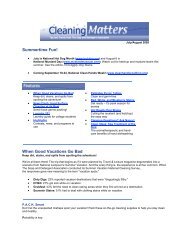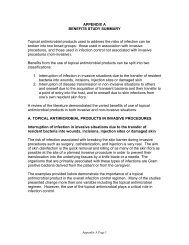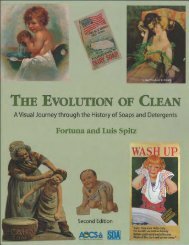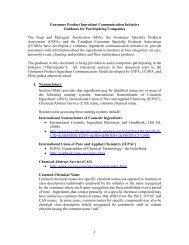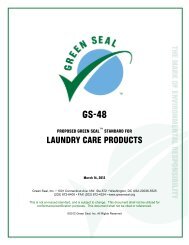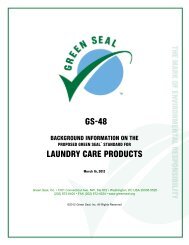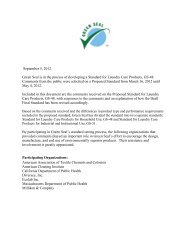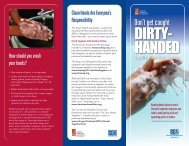subchapter c -- federal hazardous substances act regulations
subchapter c -- federal hazardous substances act regulations
subchapter c -- federal hazardous substances act regulations
Create successful ePaper yourself
Turn your PDF publications into a flip-book with our unique Google optimized e-Paper software.
16 CFR Ch. II (1–1–05 Edition) – proposed modification – 6/25/06<br />
Positive” in the EPA guidelines on male<br />
reproductive risk assessment.<br />
(ii) Probable Human Male Reproductive<br />
Toxicant. A substance is considered a<br />
”probable human male reproductive toxicant”<br />
if there is ”limited” human evidence or<br />
”sufficient” animal evidence to establish a<br />
causal association between human exposure<br />
and the adverse effects on male reproductive<br />
main endpoints. This category is comparable<br />
to the one termed ”Probable Positive” in the<br />
EPA guidelines on male reproductive risk<br />
assessment. However, the EPA category is<br />
based only on sufficient animal evidence.<br />
CPSC believes that limited human evidence is<br />
also sufficient for a chemical to be placed in<br />
this category.<br />
(iii) Possible Human Male Reproductive<br />
Toxicant. A substance is considered a<br />
”possible human male reproductive toxicant”<br />
if there is limited animal evidence, in the<br />
absence of human data, or in the presence of<br />
inadequate human data, or which does not fall<br />
into any other group, to establish a causal<br />
association between human exposure and<br />
adverse effects on male reproductive main<br />
endpoints. This category is comparable to the<br />
one termed ”Possible Positive A” in the EPA<br />
guidelines on male reproductive risk<br />
assessment. EPA proposes to use either limited<br />
human or limited animal evidence data to<br />
classify a toxicant as a ”Possible Positive A”<br />
toxicant. As described above, CPSC would<br />
elevate limited human evidence to the category<br />
”Probable Human Male Reproductive<br />
Toxicant.”<br />
(4) Female Reproductive Toxicants.<br />
Female reproductive toxicants can be grouped<br />
into the following different categories based<br />
on evidence obtained from human or animal<br />
studies. EPA has proposed guidelines for<br />
assessing female reproductive risk but has not<br />
yet proposed a specific system for<br />
categorization of female reproductive<br />
toxicants.<br />
(i) Known Human Female Reproductive<br />
Toxicant. A substance is considered a ”known<br />
human female reproductive toxicant” if there<br />
is ”sufficient” human evidence to establish a<br />
causal association between human exposure<br />
and adverse effects on female reproductive<br />
function such as mating ability, fertility, and<br />
prenatal and postnatal development of the<br />
conceptus.<br />
-- 92 --<br />
(ii) Probable Human Female Reproductive<br />
Toxicant. A substance is considered a<br />
”probable human female reproductive<br />
toxicant” if there is ”limited” human evidence<br />
or ”sufficient” animal evidence to establish a<br />
causal association between human exposure<br />
and adverse effects on female reproductive<br />
function.<br />
(iii) Possible Human Female Reproductive<br />
Toxicant. A substance is considered a<br />
”possible human female reproductive toxicant”<br />
if there is ”limited” animal evidence, in the<br />
absence of human data, or in the presence of<br />
inadequate human data, or which does not fall<br />
into any other group, to establish a causal<br />
association between human exposure and<br />
adverse effects on female reproductive<br />
function.<br />
(d) Germ Cell Mutagenicity. Substances<br />
are toxic by reason of their germ cell<br />
mutagenicity when they are known to induce<br />
heritable mutations or regarded as if they<br />
induce heritable mutations in the germ cells of<br />
humans.<br />
(1) Known Germ Cell Mutagenicity<br />
Substances. Substances are known to induce<br />
heritable mutations in the germ cells of<br />
humans based on positive evidence from<br />
human epidemiological studies.<br />
(2) Substances regarded as if they induce<br />
heritable mutations in the germ cells of<br />
humans. Substances should be regarded as if<br />
they induce heritable mutations in the germ<br />
cells of humans based on:<br />
• Positive result(s) from in vivo heritable<br />
germ cell mutagenicity tests in mammals; or<br />
• Positive result(s) from in vivo somatic cell<br />
mutagenicity tests in mammals, in<br />
combination with some evidence that the<br />
substance has potential to cause mutations to<br />
germ cells. This supporting evidence may, for<br />
example, be derived from<br />
mutagenicity/genotoxic tests in germ cells in<br />
vivo, or by demonstrating the ability of the<br />
substance or its metabolite(s) to inter<strong>act</strong> with<br />
the genetic material of germ cells; or<br />
• Positive results from tests showing<br />
mutagenic effects in the germ cells of humans,<br />
without demonstration of transmission to<br />
progeny; for example, an increase in the<br />
frequency of aneuploidy in sperm cells of<br />
exposed people.<br />
(3) Other Considerations. Conclusions<br />
about heritable effects in human germ cells



